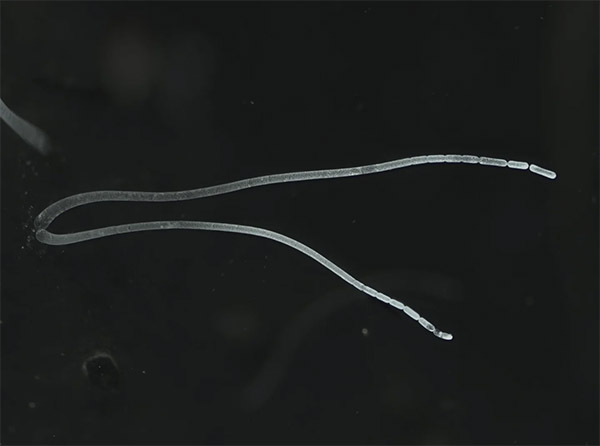Creature Feature: A Macroscopic Microbe
June 23, 2022
I just saw this paper and it made me really excited, so here's a Creature Feature fueled by pure biology hype!
Today's Featured Creature is Thiomargarita magnifica, a species of bacteria described in a paper by Volland et al. that was just published today in Science. The bacteria live in mangrove leaf litter in Guadeloupe and survive by oxidizing sulfur. The genus name Thiomargarita means sulfur pearl, referring to the appearance of the cells. The sulfur particles they contain give them an iridescent sheen.
The species was discovered in 2009 by Dr. Olivier Gros, who originally thought it was a fungus. That may seem like a weird mistake to make; after all, microscopic fungi exist, but how would you get a eukaryote and a prokaryote confused?
The problem is that individual T. magnifica cells look like long filaments that can grow up to 2 centimeters long. Centimeters.
Photo of T. magnifica cells

T. magnifica next to a dime for scale. Photo: Tomas Tyml/Lawrence Berkeley National Laboratory
It took several years of research for one of Gros' colleages, Dr. Silvina González Rizzo, to confirm that these filaments are actually bacteria (and that one filament is indeed one cell). She also named the species; she said she chose the species name magnifica "because magnus in Latin means big and I think it’s gorgeous, like the French word magnifique."
T. magnifica's size already makes it quite the special bug. Another Thiomargarita species, T. nabimiensis, was previously the largest known bacterium, but it clocked in at a record size of 0.75mm; T. magnifica dwarfs it and then some. And, as Gros' student Jean-Marie Volland would find out, there's even more to it on the inside!
The majority of the cell is occupied by what is essentially a large water balloon, referred to as a vacuole. T. nabimiensis also contains a vacuole, which is hypothesized to be responsible for its size. The vacuole allows the cell to grow large without having a proportionally large amount of cytoplasm, and it stores nitrates (the compound it needs to generate energy) that allow it to withstand long periods of starvation. The vacuole in T. magnifica may serve a similar purpose.
The cytoplasm, which is squished between the cell wall and the vacuole, contains the cell's DNA and ribosomes (the cell's protein makers). The DNA and ribosomes are free-floating in most bacteria, with the DNA contained in circular chromosomes. In T. magnifica, however, the DNA and ribosomes are contained in membrane-bound compartments that the biologists dubbed pepins, after fruit seeds (think pepitas). This poses a bit of a problem for our current definition of prokaryotes, which states that they don't have membrane-bound organelles!
T. magnifica also has a fittingly large genome, consisting of 11 million base pairs with at least 11,000 genes. (Bacteria usually have about a third of that many genes). On top of that, it exhibits extreme polyploidy, meaning that it contains multiple copies of its genome - hundreds of thousands of copies, specifically.
Microscope photo of T. magnifica

A single T. magnifica cell. Photo: Jean-Marie Volland/Lawrence Berkeley National Laboratory
A discovery this extraordinary has left the researchers with a whole stack of research questions. The role of T. magnifica and its chemosynthetic abilities in its ecosystem is unknown. It's also not known whether its sulfur-rich habitat contributes (or is essential) to its size. The pepins pose another mystery: individual pepins weren't sequenced, so it's undetermined whether each pepin contains the same mix of DNA, ribosomes, and protein. If they do, it's unknown whether one pepin corresponds to one copy of the genome, or if there are more. The precise function of pepins, their formation and mechanisms, and whether they occur in other species of bacteria are also all open questions.
And, of course, there's the evolutionary speculation. Some people have already posited theories about these bacteria being a "missing link," a transitional prokaryotic-eukaryotic organism. Others have refuted these theories. If I may editorialize, I agree with the latter camp here; I think the idea that a bacterium could only be "advanced" as part of a grand evolutionary plan to eventually become eukaryotic is insulting to bacteria and just bad science. (There's a lot of bad science in evolutionary biology, but I digress.)
I once heard an analogy that studying natural science is like watching a sport you're not familiar with and trying to deduce the rules just from what happens in a game. Once again, humanity's attempts to neatly categorize the world have been foiled, everything we thought we knew is imploding, and that's great. (Really!) Given the mind-blowingly large amount of bacteria out there, I don't think T. magnifica is unique, and the authors agree: "The discovery of Thiomargarita magnifica suggests that bigger and more complex bacteria could be hiding in plain sight," they conclude.
I used this article and this press release for background information.